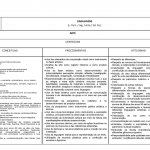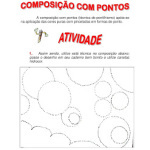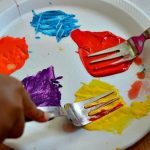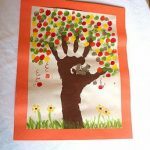
In today's post, we will bring a lesson plan about visual arts for early childhood education, for you to take to your students, teaching them the importance of art in a playful, fun and interactive way.
The visual arts are present in everyone's daily life, as we are surrounded by images. That's why working with the Arts is very important in personal development, especially during childhood. Although the activities seem kind of dynamic, they are actually cognitive, artistic, creative exercises.

OBJECTIVE: Produce artwork, using the language of modeling, exploring the textures of objects and materials; Make a three-dimensional sculptural artwork; Recognize the use in the social context of the prescriptive textual genre - recipe.
CONTENTS: Exploration and deepening of the possibilities offered by the various materials, instruments and supports necessary for artistic making; Exploration of three-dimensional space in the realization of your artistic projects; Appreciation of their productions and those of others, through observation and reading of some of the elements of plastic language; Reading and understanding short texts.
METHODOLOGY OF PEDAGOGICAL ACTION: The class will be held in the classroom in an interdisciplinary way, with appreciation of the sculpture by Mestre Vitalino, notation of activities where recipes are used in everyday life, making plasticine, making sculptures and appreciating their own productions. For the development of the class, a poster containing the recipe, a sculpture by Mestre Vitalino and clay, wheat flour, basin, salt, vinegar, water, gouache of different colors for modeling clay, paper wood and various objects with combs, stones, toys, etc.
ACTIVITY PLAN
1st moment At first, in a conversation circle, the teacher will present a sculpture by Mestre Vitalino, for appreciation, where the children will be instructed to read and analysis of the work, during the dialogue, the teacher will comment on characteristic facts of the sculptures of Mestre Vitalino and that are striking in his life. It is clear to the children the raw material used by Vitalino in the making of his works (clay/clay), which will also be presented to the children so that they can feel their texture.
2nd moment Afterwards, in a circle on the living room floor, the children will receive some guidance, mentioning that the next activity is the manufacture of plasticine, which is a material with a texture similar to clay, but with other Ingredients. At this point the children will receive a medium bowl and small portions of the previously separated ingredients. At first, the teacher will work on orality, talking about the recipe, what it is for, who has witnessed the mother preparing a dish, exposing a little of the prescriptive textual genre, etc. Then the teacher will present a poster containing the recipe for the dough, after reading, the manufacture will be performed in step with the instructions received from reading the recipe on the poster. First the wheat, then the salt, the vinegar, the water, after mixing them to give color with gouache (each child will receive a different color). During manufacture, the child will be encouraged to observe and comment on the texture of the separate ingredients, mixing them and then the ready-made dough.
3rd moment After cleaning the room, the children will relate similarities and differences in the texture of clay and play dough with other objects that will be available, such as combs, stones, fabrics, etc. This activity aims to develop observational skills and tactile sense.
4th moment On the wood paper, the children will produce objects, animals in sculpture with the play dough giving freedom to their creativity, at this time there will be an exchange between children in exchange for play dough and in the comments resulting from the process from creation. After the sculptures are made, the children, with the help of the teacher, will organize the room, and store the rest of the dough in plastic bags in the refrigerator.
. 5th moment Once the room is organized, an exhibition of the sculptures will be held, firstly inside the room itself and then to the garden I. Where each child will talk about their sculpture, their creation process, what they represent, what motivated them to make it, etc.
ASSESSMENT: The class was very fruitful, there was a good understanding of the proposal by the children, reaching the outlined objectives, they managed to manufacturing the dough and also making the sculpture, as well as identifying the situations where the recipe can be used and how it serves us in the day. to day. They were fully involved, participating in every moment of the class with attention and joy. It was extremely pleasing to see the enchantment of the children during their creation process, as well as the comments, explored the colors a lot, forming colorful displays, gigantic animals, others little ones. In the beginning, some stuck to just two colors, they were still a little shy, but with the teacher's motivation they were able to act on the mass with more propriety. The class went smoothly, there was no ingestion problem, only small impasses that were easily resolved.
BIBLIOGRAPHY: Porto, Amelia. New Doing and Learning. 1st year elementary school/ Amélia Porto and Maria Luisa Aroeira; student's book- Belo Horizonte: Dimension, 2008.
CONCLUSION: Teaching Arts means going beyond the mere production of drawings and painting, where the child is left adrift in a class understood as time from rest, Arts is language and as such it is essential to develop cognitive, sensitive and cultural aspects, thus the Teaching of Arts means to articulate the three conceptual fields: artistic making, appreciation and reflection based on the cultural development of kid. This work carried out in Visual Arts does not aim at technical results in perfect constructions, but the pleasure of exploring and getting to know different materials. This teaching posture instilled skills, competence, appreciation and interpretation of the world through observation of colors, images, harmony of sounds, appreciation of their own productions, thus constituting their own language artistic.
Did you like it? Share this post on your social network
 6TH TO 9TH YEAR ARTS CLASS PLAN
6TH TO 9TH YEAR ARTS CLASS PLAN
 Arts Activities print
Arts Activities print
 6 SCHOOL ARTS FOR EARLY CHILDHOOD EDUCATION
6 SCHOOL ARTS FOR EARLY CHILDHOOD EDUCATION
 SELF PORTRAIT ACTIVITIES
SELF PORTRAIT ACTIVITIES
 ARTISTIC ACTIVITIES FOR EARLY CHILDHOOD EDUCATION
ARTISTIC ACTIVITIES FOR EARLY CHILDHOOD EDUCATION
 ARTS ACTIVITIES FOR EARLY CHILDHOOD EDUCATION
ARTS ACTIVITIES FOR EARLY CHILDHOOD EDUCATION
This site uses Akismet to reduce spam. Learn how your comment data is processed.
